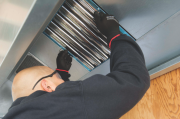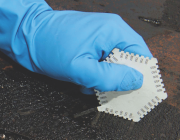Gary Nicholls, managing director of Swiftclean
 Airborne fat, oil and grease is a natural by-product of even the healthiest diet. Carried in the steam that rises from cooking, grease and oil particles are drawn into the kitchen extract system to be vented away to the outside. As the exhaust stream cools, grease is deposited on the metal surfaces of the hood, canopy, filters, canopy plenum, fan and ductwork. Although the kitchen crew or regular cleaners may be able to clean filters or clean the exterior of the canopy and canopy plenum, cleaning the extract system itself is a ventilation cleaning specialist task, essential for hygiene, but also, just as importantly, for fire safety compliance.
Airborne fat, oil and grease is a natural by-product of even the healthiest diet. Carried in the steam that rises from cooking, grease and oil particles are drawn into the kitchen extract system to be vented away to the outside. As the exhaust stream cools, grease is deposited on the metal surfaces of the hood, canopy, filters, canopy plenum, fan and ductwork. Although the kitchen crew or regular cleaners may be able to clean filters or clean the exterior of the canopy and canopy plenum, cleaning the extract system itself is a ventilation cleaning specialist task, essential for hygiene, but also, just as importantly, for fire safety compliance.
 Deposits of grease within the extract system can harbour germs and trap dirt particles and even attract insects such as cockroaches. A severe build up can result in an insect infestation, so it is essential that grease deposits are regularly and thoroughly removed.
Deposits of grease within the extract system can harbour germs and trap dirt particles and even attract insects such as cockroaches. A severe build up can result in an insect infestation, so it is essential that grease deposits are regularly and thoroughly removed.
Hygiene is not however the main imperative; the presence of grease inside extract ductwork represents a very real fire hazard. Should a kitchen fire reach the extract ductwork, or a flash fire occur in the extract system, then the accumulated grease deposits can act as fuel, helping to spread the fire. The ductwork itself can also help to spread the fire, acting as a chimney through which smoke and flames can travel, spreading the danger to the other parts of the building and potentially to neighbouring properties.
It is all too common for fire to travel, through greasy ductwork, from the kitchen, usually on the ground or basement floor, to the upper floors of the building. In hotels, this will put the guest bedrooms at risk. In fast food outlets, which are routinely located on the ground floor below offices, surgeries and apartments, many other businesses can be disrupted and lives of residents in upper or adjacent buildings may be threatened. In order to counter this potential fire risk, operators of commercial kitchens are required to comply with a new standard for the fire safety management of grease accumulation in kitchen extract systems, TR19 Grease.
This was born out of the former TR/19 guidance document, which was issued by the BESA. In 2019, section 7 of TR/19, which concerned the cleaning of kitchen extract ductwork, was made into a standard in its own right. TR19 was also reissued without section 7 to provide guidance on the cleaning of mechanical ventilation ductwork cleaning, which is also essential to maintain a healthy indoor atmosphere. This is now under review and will eventually be reissued as TR19 Air.
The layer of grease which represents a potential fire risk is nowhere near as thick as most people think. In accordance with TR19 Grease, the grease layer must be controlled within an average thickness of just 200 microns, which is about half the thickness of the average business card.
Compliance is also essential to ensure that you don’t compromise your buildings insurance. If a fire should break out and the ductwork can be shown not to have been cleaned in accordance with TR19 Grease, many insurers will now refuse to pay out on a claim.
Under the Regulatory Reform (Fire Safety) Order 2005, you must appoint a Responsible Person for your premises, and their duties must include ensuring that kitchen extract ductwork is cleaned in accordance with TR19 Grease. If the Responsible Person fails to comply with TR19 Grease, and a fire occurs, they may be charged with negligence. The penalties for negligence can be severe, especially if a fatality has occurred, and can include the possibility of a custodial sentence.
TR19 Grease contains helpful tables which outline the frequency of cleaning required, according to how heavily and often the extract ductwork is in use. However, accessing the system is usually a specialist task. TR19 Grease recommends appointing a cleaning provider registered with BESA’s certification arm, BESCA’s, Vent Hygiene Elite (VHE) scheme. VHE members must provide fully qualified, competent technicians who are trained to BESA GHT level. They will also be able to provide post-clean certification through BESCA. This will incur a small charge but it may prove vital either in processing a successful insurance claim or to protect the Responsible Person from prosecution.
A VHE member will be able to ensure legal compliance, a reduced risk of fire and greater hygiene in your kitchen; items which should always be on every maintenance menu.